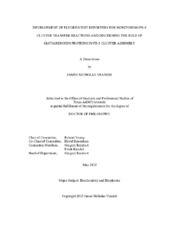| dc.description.abstract | Iron-sulfur clusters are critical cofactors in living organisms. They are synthesized using complex biosynthetic machinery that has evolved to control the reactivity of iron and sulfide and to appropriately target clusters to apo-proteins. In some bacteria and in the mitochondria of eukaryotes, iron-sulfur clusters are synthesized by the ISC machinery, consisting of a core complex of IscS (a cysteine desulfurase that produces persulfides) and IscU (a scaffold protein that assembles iron and persulfides to form clusters). The in vitro study of cluster transfer has been hampered by the lack of sufficient methods to investigate the kinetics of these processes. We have developed fluorescently labeled iron-sulfur cluster binding proteins that are sensitive to bound ironsulfur clusters. The ability of these probes to sense only bound cluster in complex mixtures with multiple proteins was demonstrated by monitoring the DTT-dependent cluster exchange between identical ferredoxin proteins.
We then applied this methodology to try to understand the role of the monothiol glutaredoxins in Fe-S cluster transfer. The monothiol glutaredoxins are thought to function as intermediate cluster carriers, carrying clusters from IscU to apo-target proteins in the cell. We demonstrate IscS:IscU dependent cluster transfer to the E. coli monothiol glutaredoxin, Grx4 and then demonstrate the ability of holo-Grx4 to transfer clusters to different [2Fe-2S] containing proteins. Finally, we use kinetic modeling to demonstrate the ability of Grx4 to function as an intermediate carrier to terminal target proteins.
Finally, we use the fluorescent labeling method to study the function of the dithiol glutaredoxins (Grx1 and Grx3) from E. coli. These proteins are less well understood, appearing to promote cell survival to toxins, although some studies suggest that they may function in Fe-S cluster transfer as well. We demonstrate that cluster transfer to Grx1 and Grx3 is highly sensitive to glutathione concentration and may function upstream of Grx4 under certain conditions. We also demonstrate that although Grx3 can transfer clusters to apo-target proteins, these terminal target proteins outcompete Grx3 for IscU bound cluster in combined reaction mixtures. Altogether, these studies demonstrate the utility of the newly developed fluorescent assays to address questions in Fe-S cluster trafficking. | en |


